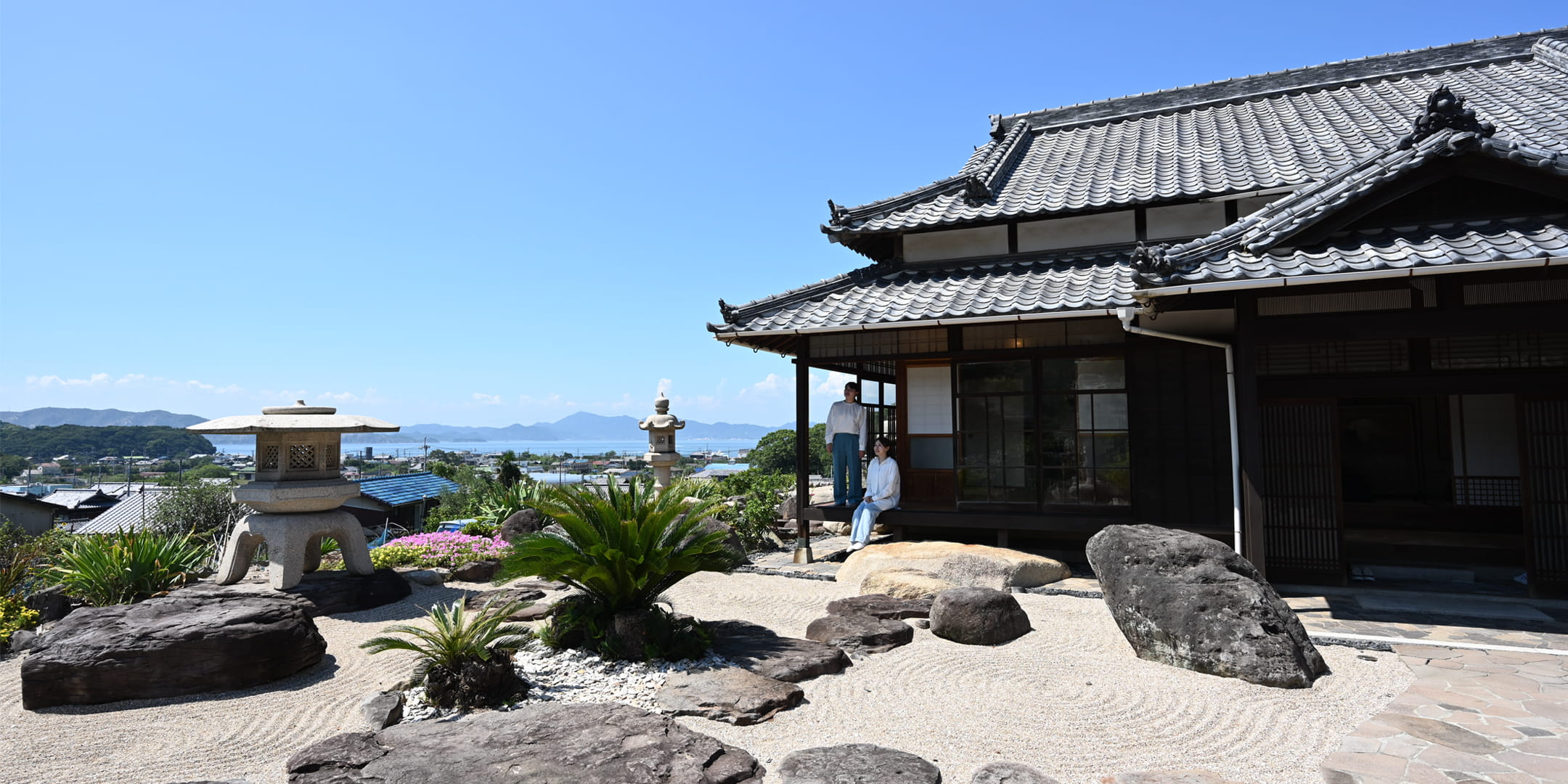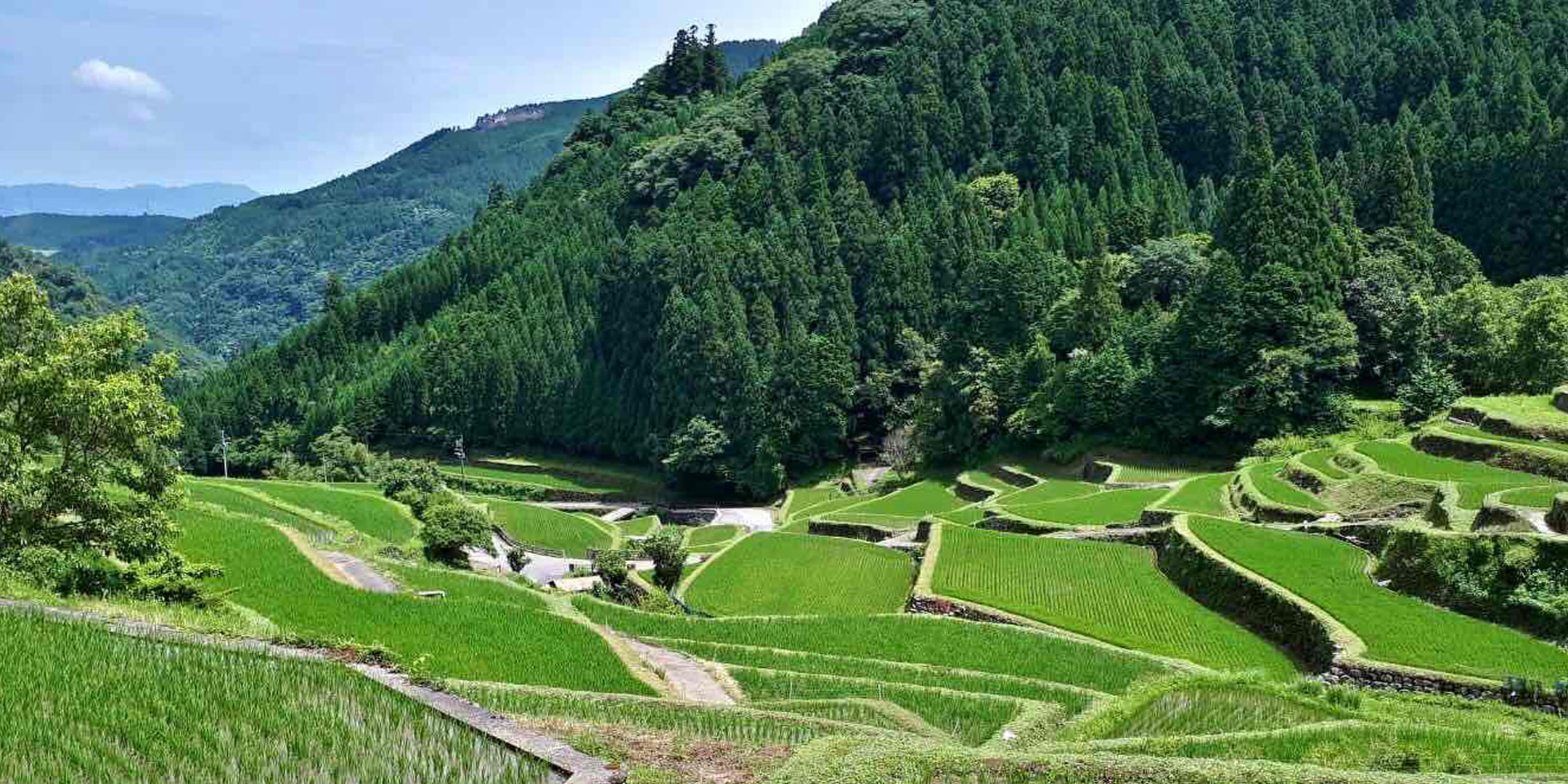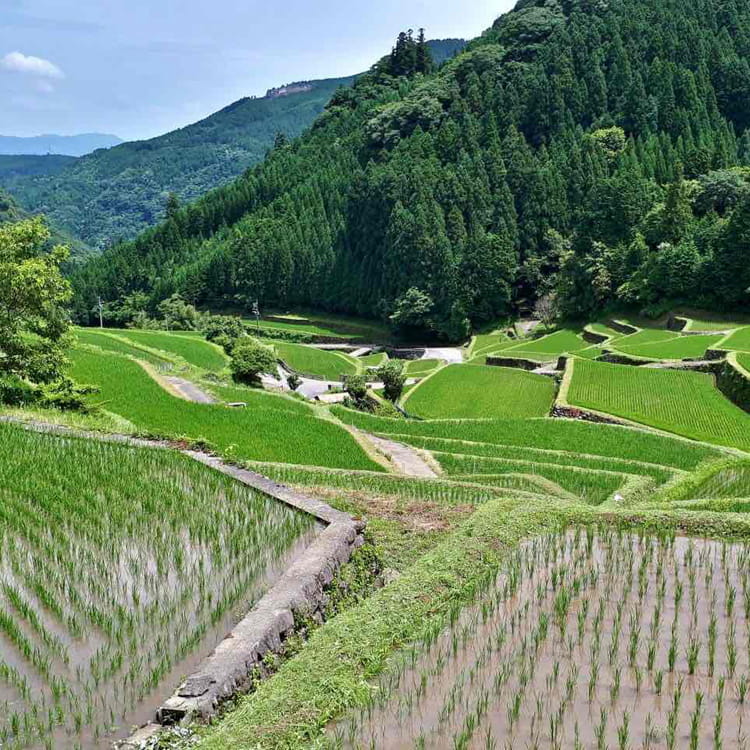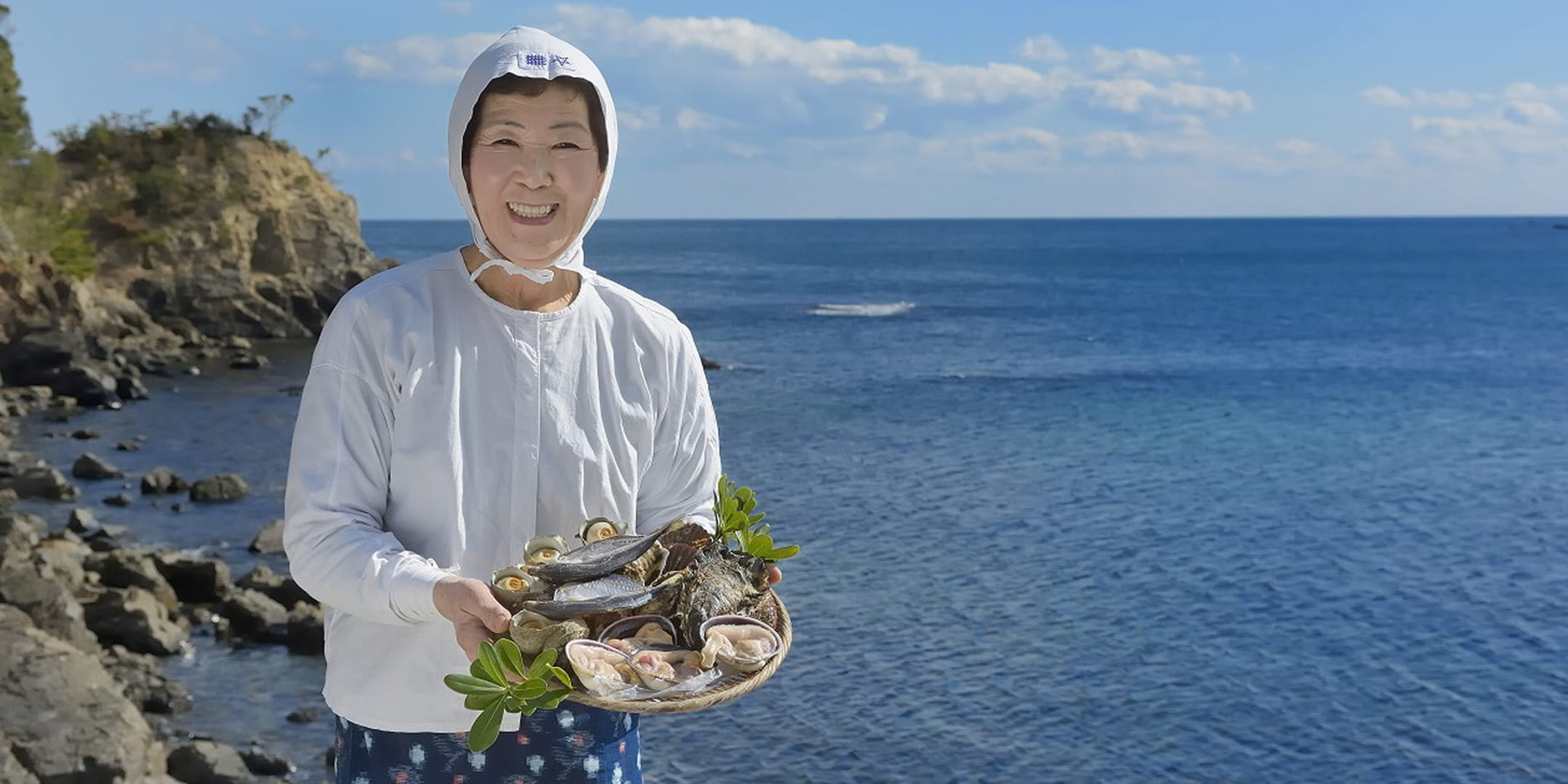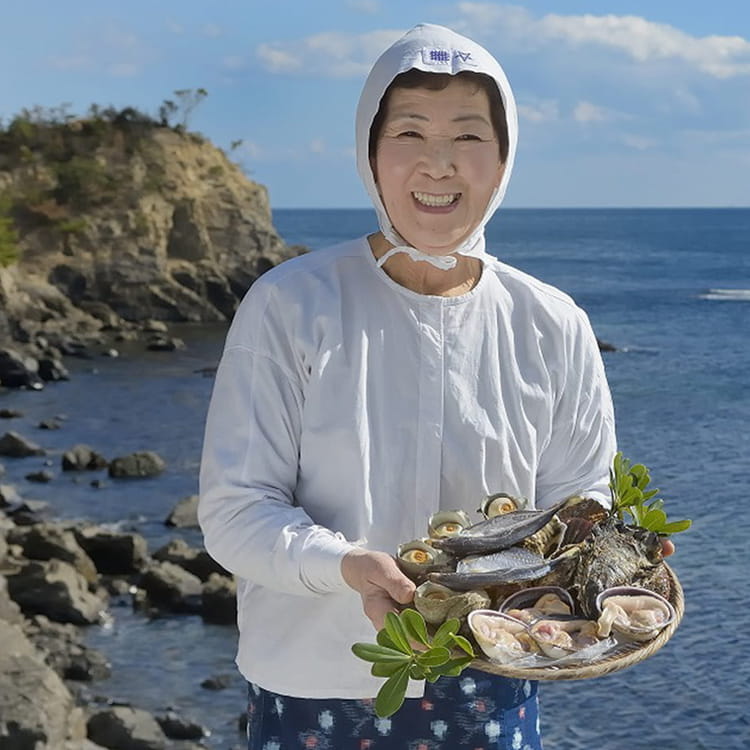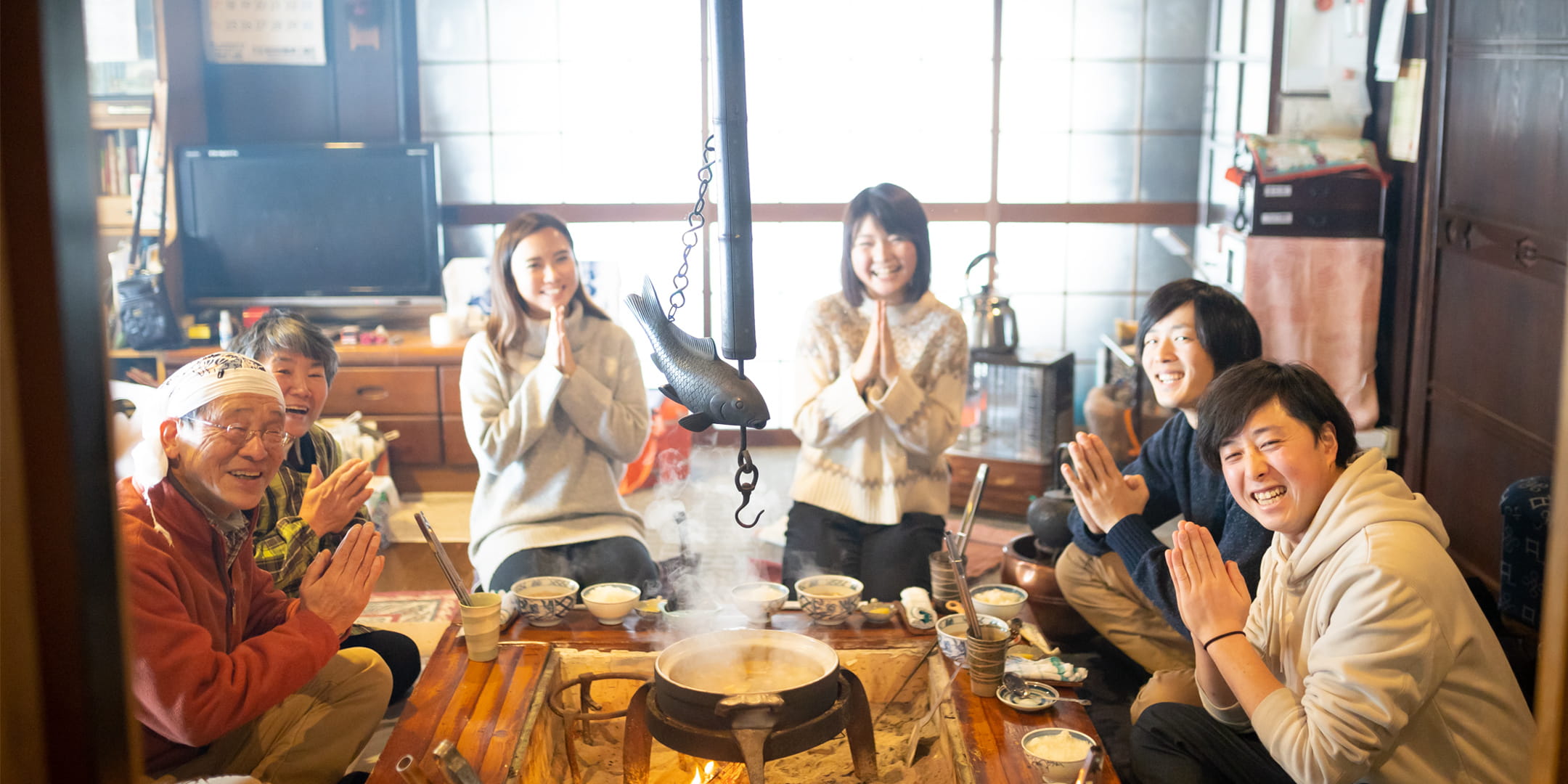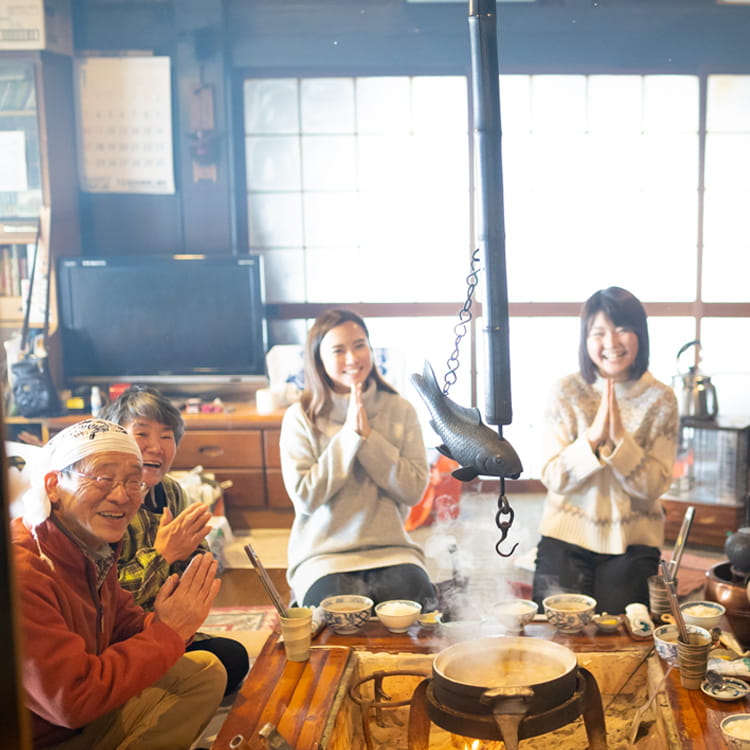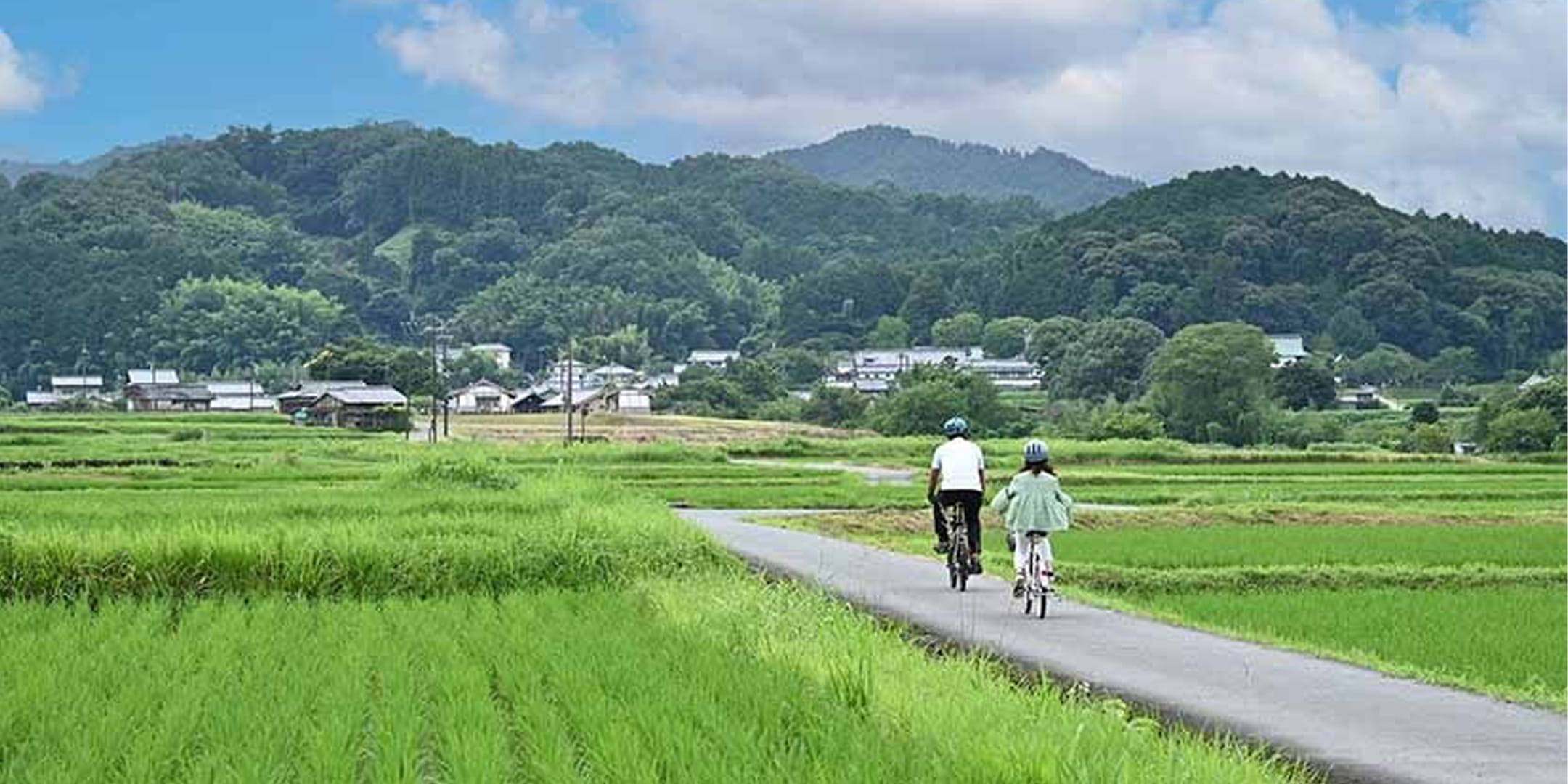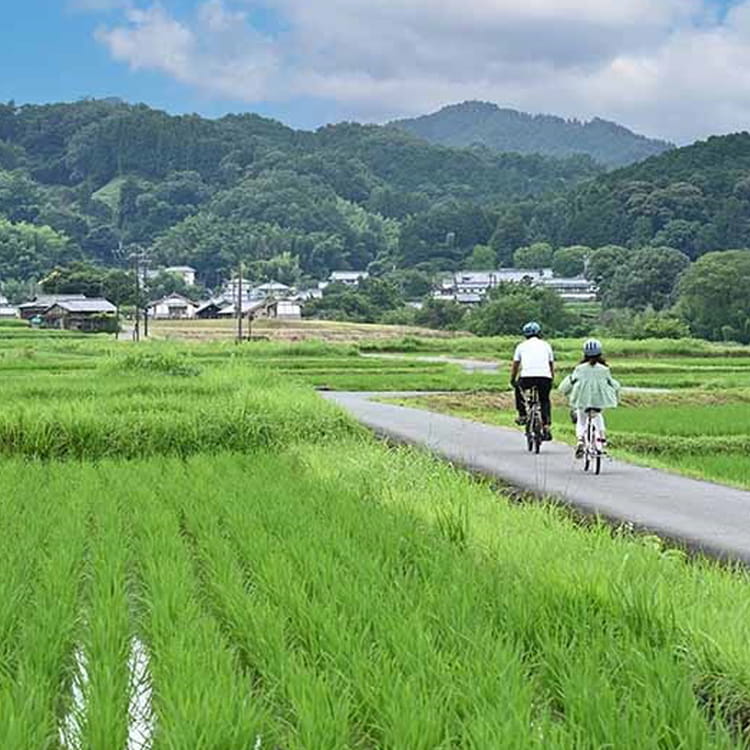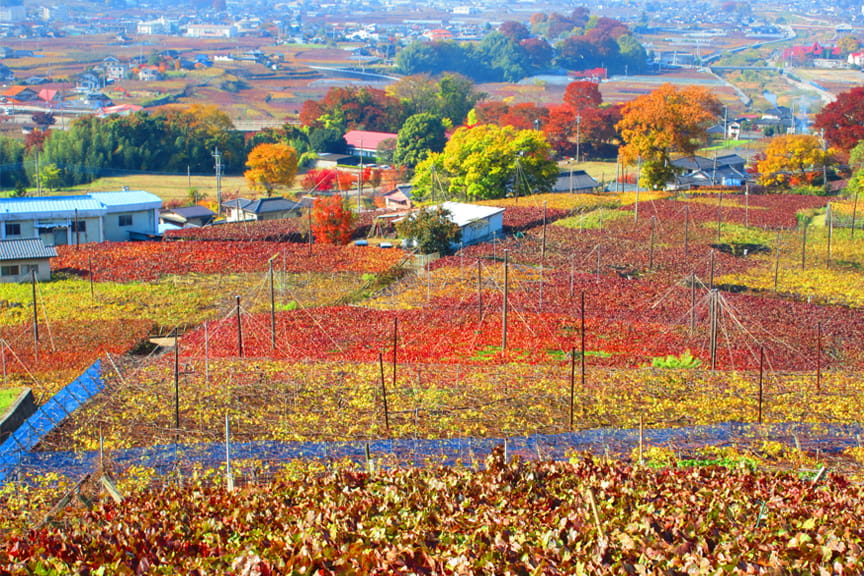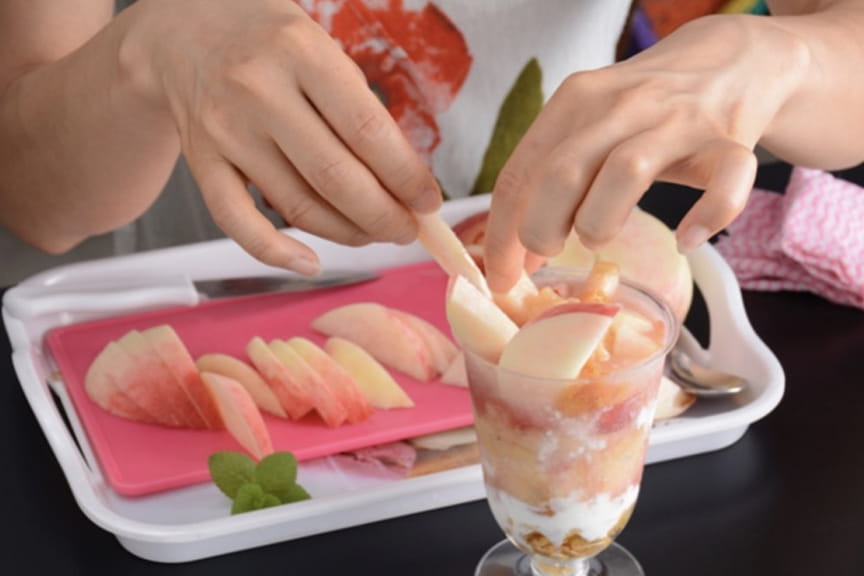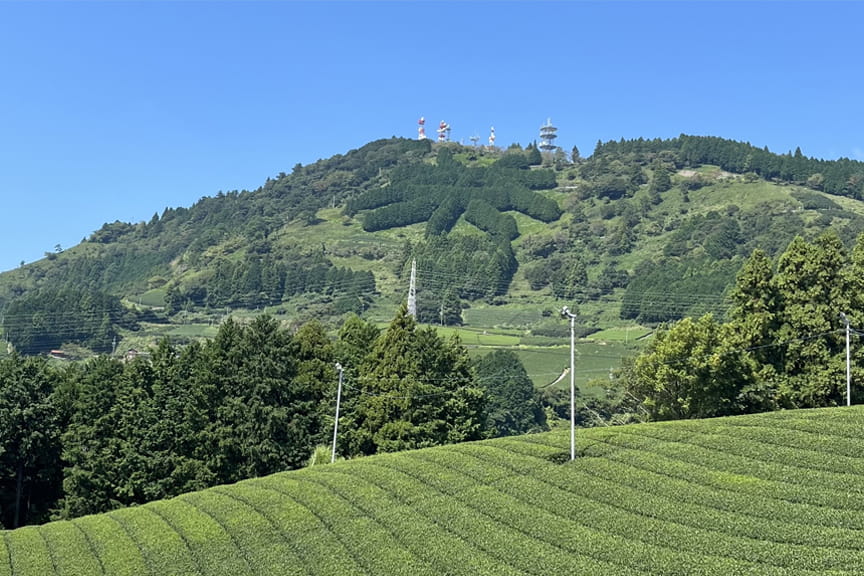Blessed with majestic mountains and surrounded by immense seas, Japan has a varied and complex natural environment that quietly blooms and flourishes, worlds away from the hustle and bustle of its huge cities. Deep in the countryside, rustic mountain and fishing villages embrace their own distinct cultures that are rooted in their vastly different climates.
Visitors fortunate enough to travel to these parts can experience the true Japan through beautiful seasonal scenery, a variety of tasty local cuisine, traditional customs, and warm interactions with friendly local people. Relax in the leisurely flow of time, which elevates Japan’s singular charms in a way not possible in cities like Tokyo and Osaka.
Add a more profound element to your travels with a trip to the enchanting Japanese countryside.
Recommended plans
Tokai Fuefuki City, Yamanashi
Journey beyond Mt. Fuji to uncover the bounties of agriculture and the wisdom of living in harmony with nature in a Globally Important Agricultural Heritage SystemThemed around exploring agricultural bounties beyond Mt. Fuji, this experiential tourism plan invites you to immerse yourself in the agricultural traditions and ways of life of Yamanashi and Shizuoka. It’s packed with opportunities to connect with the community and Japanese culture, including enjoying local wine and food pairings, arranging flowers, pruning trees in a garden, and strolling around town in a Western-style kimono.
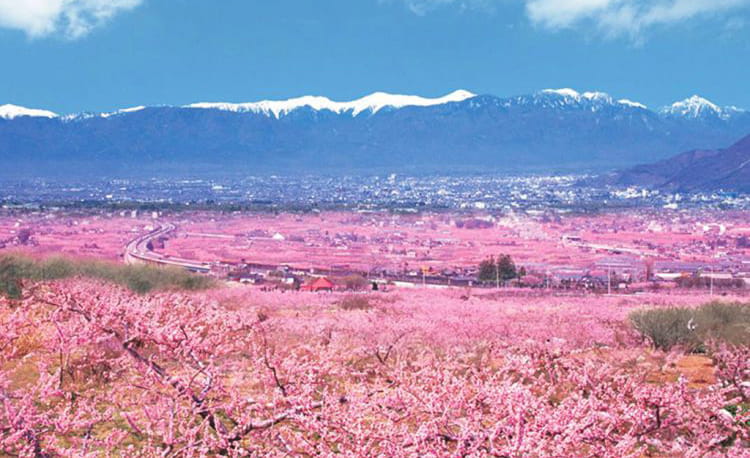
Hokuriku/Shinshu Shiramine, Hakusan City, Ishikawa
Delve into the life-sustaining waters of Mt. Hakusan, a sacred site of nature itselfThis trip takes you through the nature, history, culture, and cuisine born from the lay of the land—from Mt. Hakusan to the sea—with an emphasis on the mountain’s life-sustaining waters.
Familiarize yourself with the abundant nature brought forth by Mt. Hakusan’s heavy snowfall, the mountain’s intertwined Shinto, Buddhist, and human histories, and the varied traditions that flow from the mountain to the Sea of Japan.
Tokai Taiki Town, Mie
Kumano Kodo Iseji: A gastronomic journey connecting the sacred sites of Ise and KumanoEmbark on a gastronomic journey along a spiritual pilgrimage route that cleanses your body and soul, with a focus on three elements: pilgrimage, food culture, and unique local experiences.
Enjoy heavenly Matsusaka beef and the fresh bounties of nature, including shiitake mushrooms from the mountains, yellowtail from the sea, and ayu sweetfish from the rivers, all prepared using traditional methods.
This priceless three-day trip allows you to savor local cuisine and walk along a pilgrimage route while wearing a handmade costume.
More recommended
model courses
Hokkaido Bibai City, Hokkaido
Three days, two nights of learning, food, and encounters: Eating your way through Bibai
Hokuriku/Shinshu Teradomari, Nagaoka City, Niigata
Embark on a gastronomic tour of Teradomari, delve into a world of flavors and techniques, and experience its artisanal spirit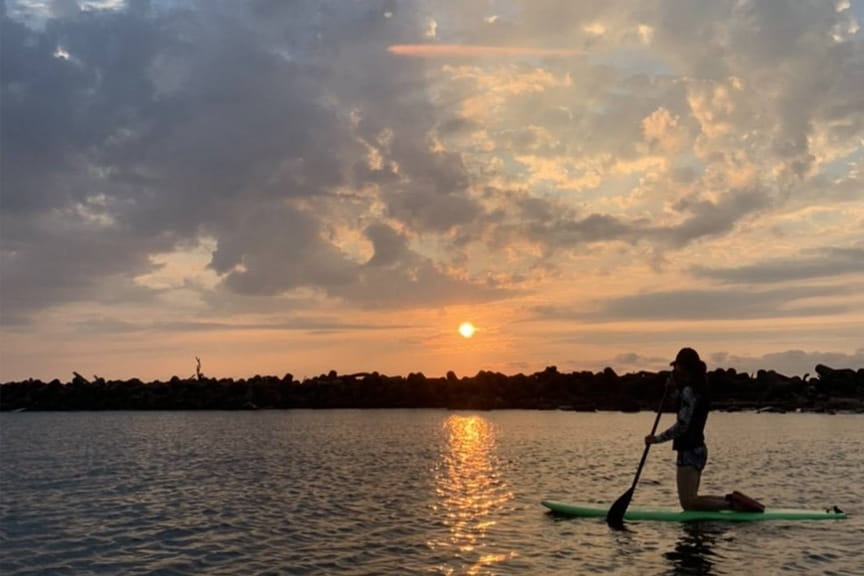
Hokuriku/Shinshu Onomi Village, Nanao City, Ishikawa
Savor the gifts of both the mountains and fertile sea in the unspoiled village of Onomi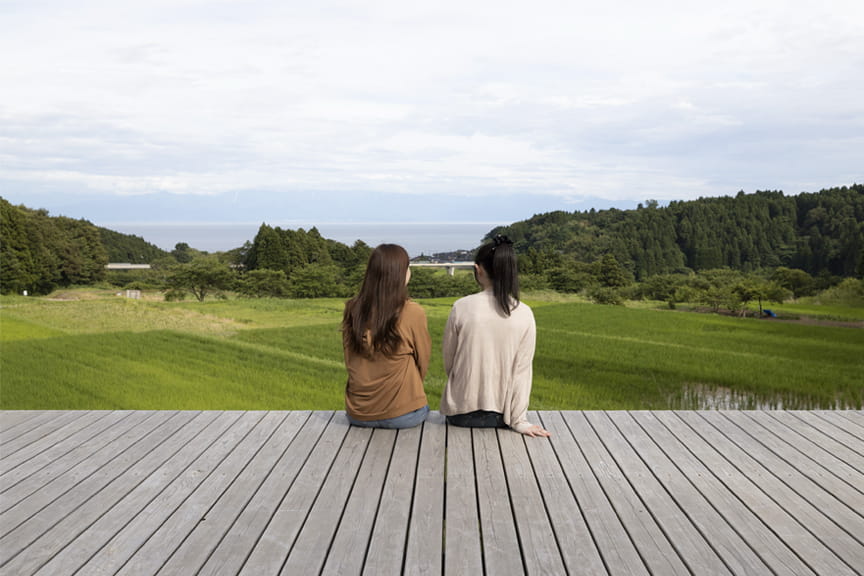
Kanto Chichibu City, Yokoze Town, Minano Town, Nagatoro Town, Ogano Town, Saitama
Embark on a journey of serenity and mindfulness in Chichibu and see Buddhist relics unveiled just once every 12 years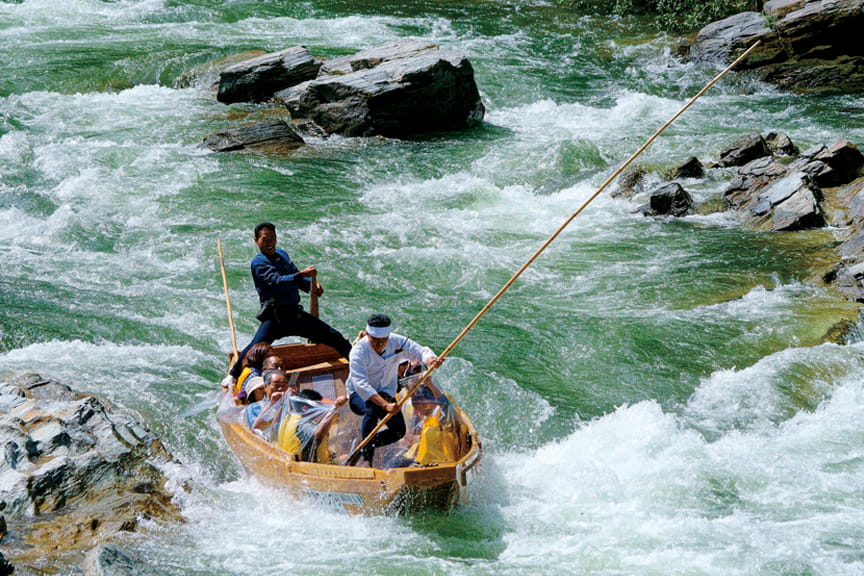
Kanto Namegawa Town, Saitama
A mystical two-day tour of Namegawa in Saitama that explores its rural satoyama ecosystem, agricultural heritage system, and traditional culture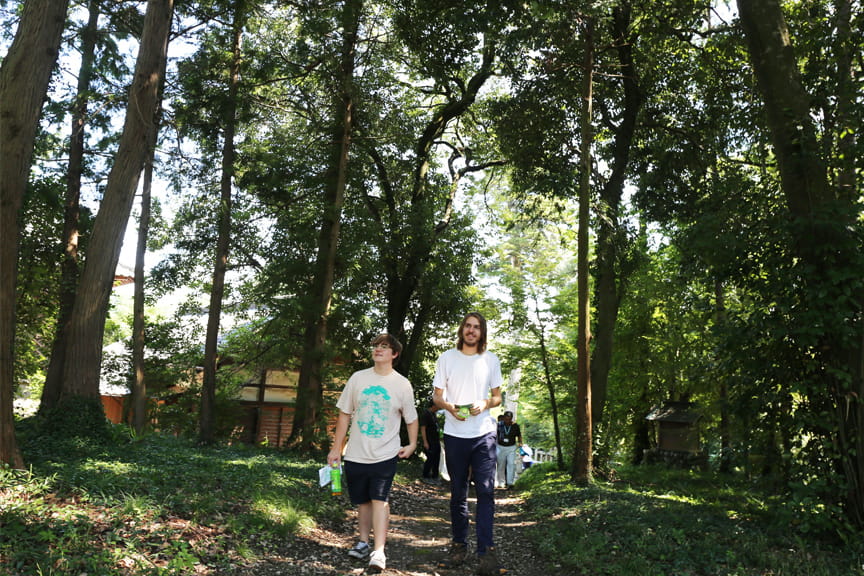
Kanto Kamakura City, Kanagawa
Embark on a sensory journey that explores the former samurai capital of Kamakura, Zen, and agriculture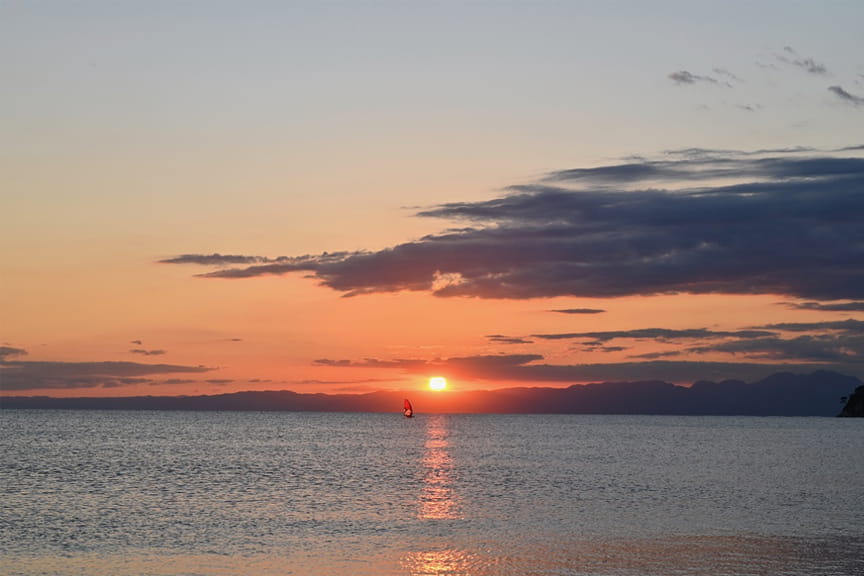
Tokai Minobu Town, Yamanashi
Enjoy a countryside stay on Mt. Minobu, one of the three most sacred mountains in Japanese Buddhism, that highlights the timeless nature of Buddhist culture, traditional crafts, and the land’s bounty from the past into the future
Kansai Miyama Town, Nantan City, Kyoto
Take a deep dive into rice-based traditions from Miyama to Fushimi and the lives connected by rice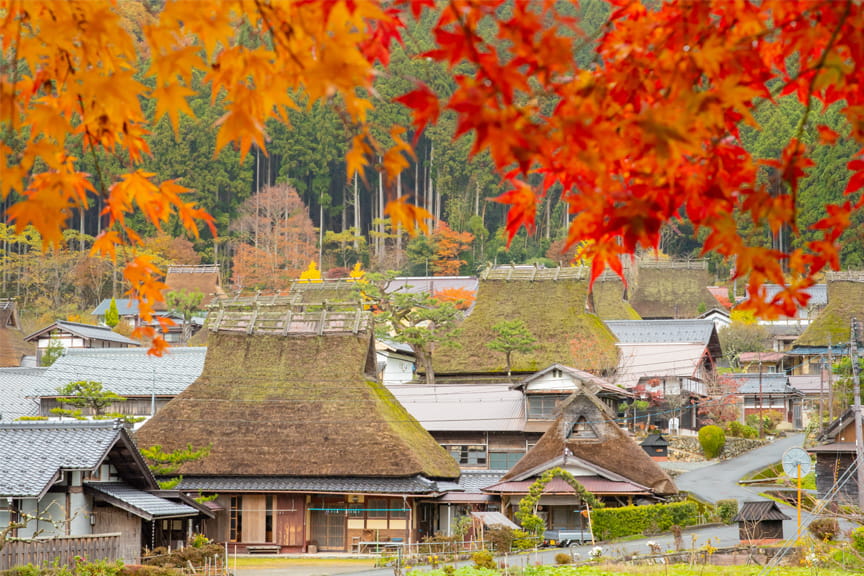
Kansai Gose City, Nara
Engage in gastronomy tourism where Japan’s story began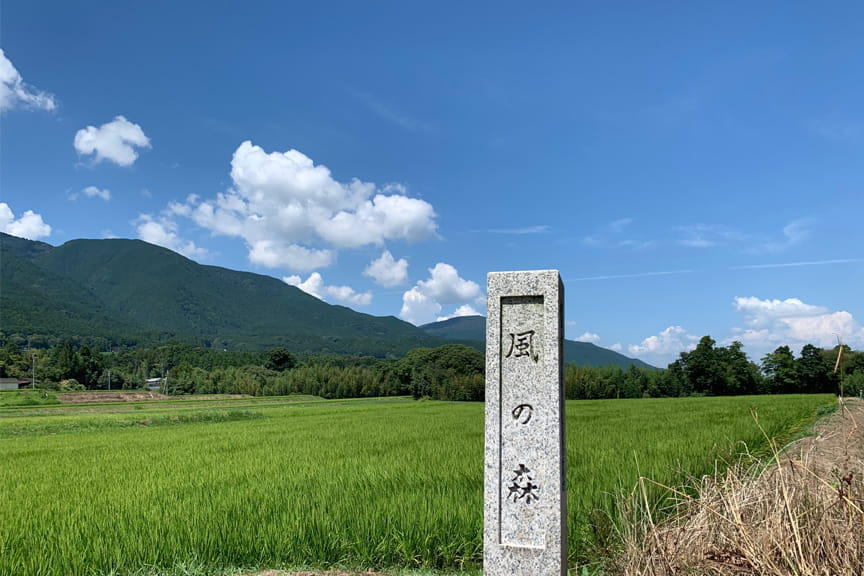
Kansai Ota River Basin, Nachikatsuura Town, Wakayama
A life and prayer farm-stay retreat in Kuman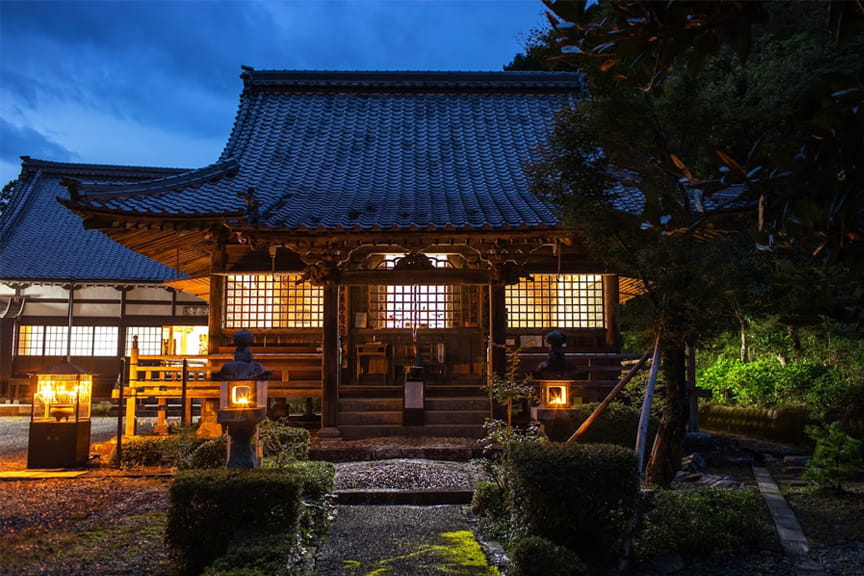
Shikoku Nishi-Awa Area (Mima City, Miyoshi City, Tsurugi Town, Higashimiyoshi Town), Tokushima
Immerse yourself in the wonders of the “Nishi-Awa Steep Slope Land Agriculture System,” a Globally Important Agricultural Heritage System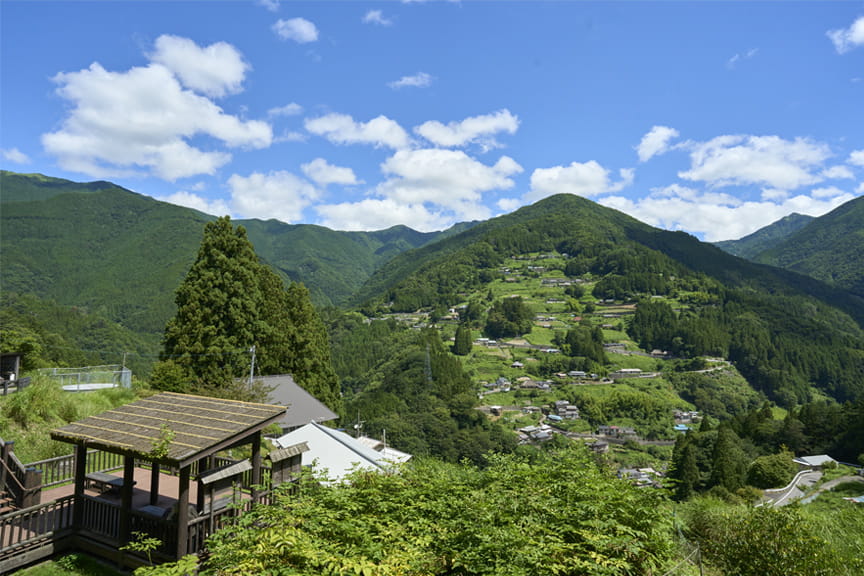
Shikoku Teshima Island, Tonosho Town, Kagawa
Teshima in the Seto Inland Sea: The story of an island connected by water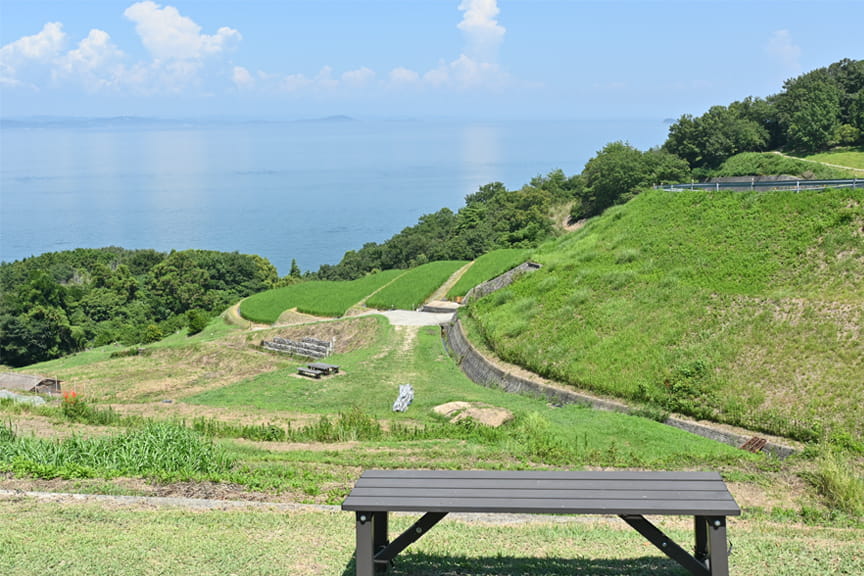
Okinawa Ogimi Village, Okinawa
Yonna! Take it easy and enjoy agriculture and adventure in Okinawa’s Ogimi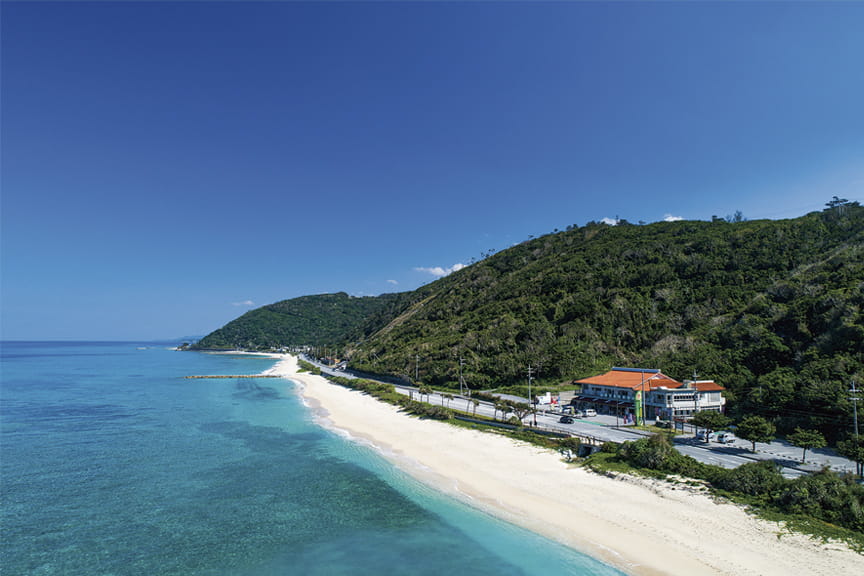
Recommended Regions
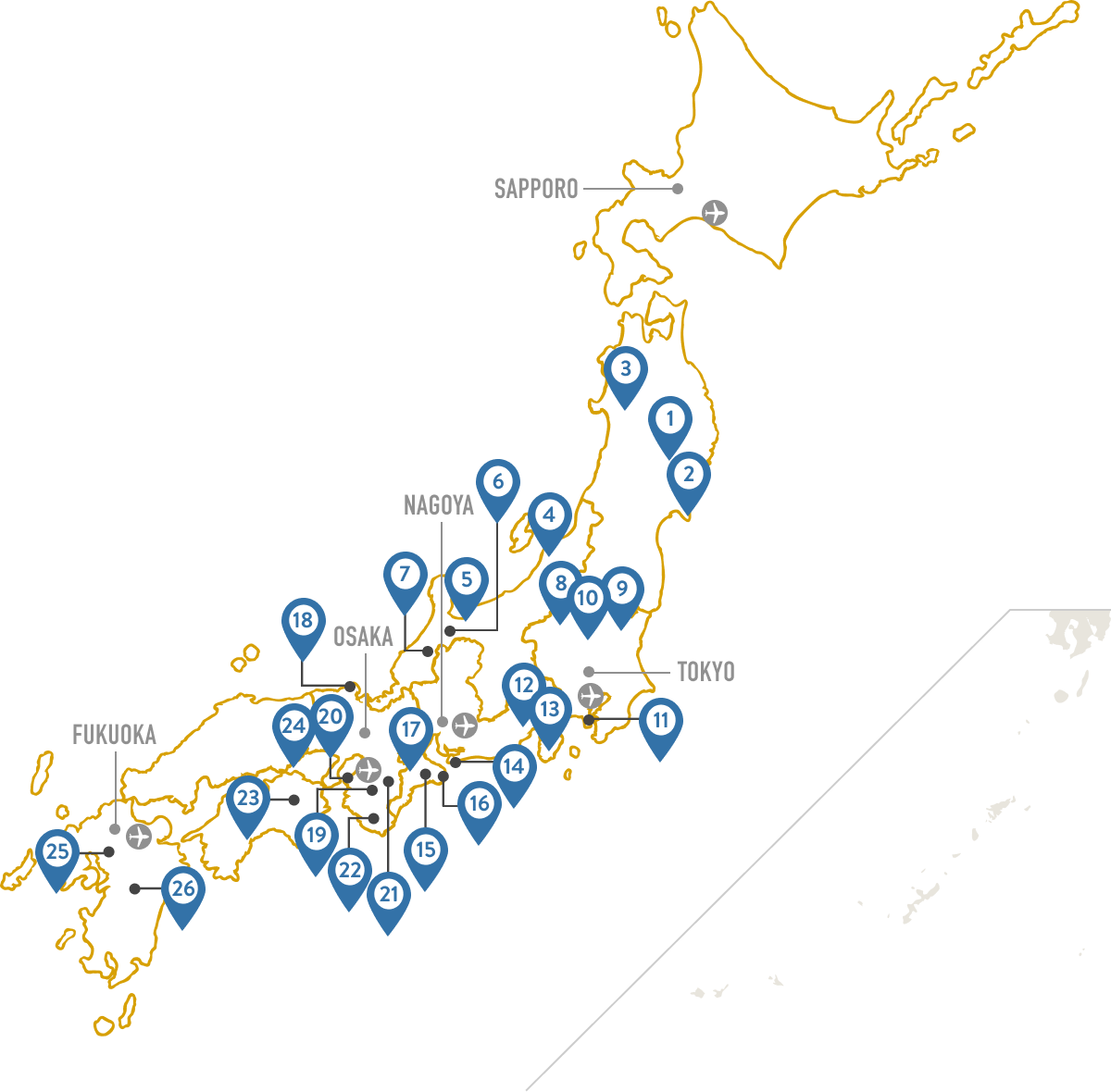
Hokkaido
Tohoku
Hokuriku/
Shinshu
Kanto
Tokai
Kansai
Shikoku
Kyushu
Okinawa
Bibai City, Hokkaido
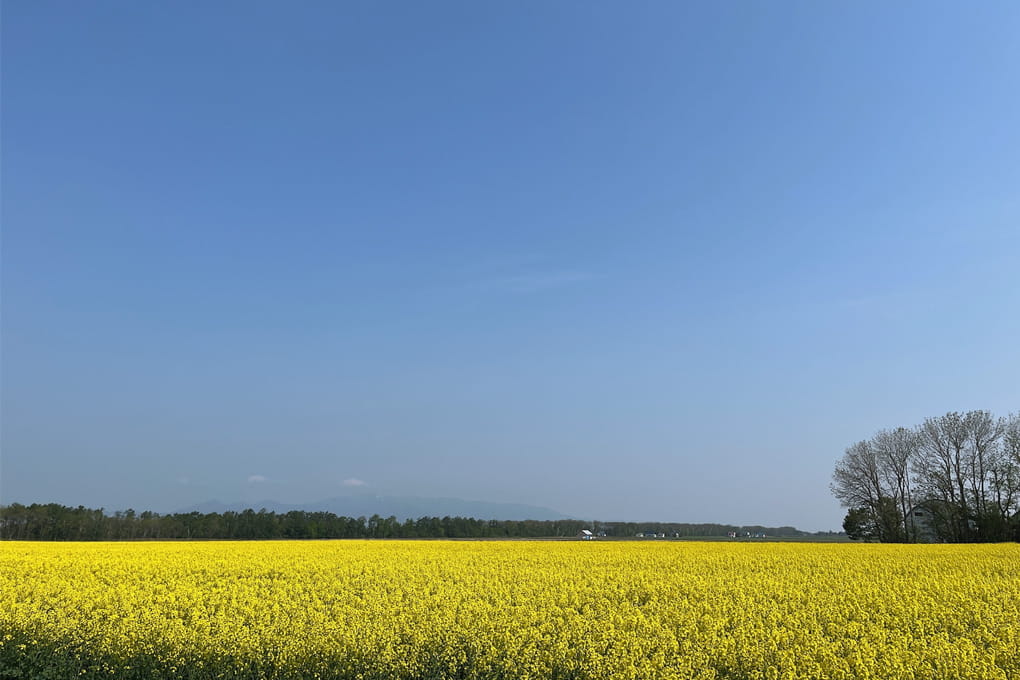
Located in central Hokkaido just an hour’s drive from Sapporo, Bibai City is a treasure trove of nature. This slow-paced and peaceful rural town makes the ideal base for visiting the tourist attractions of Asahikawa City, Furano City, and Biei Town. Visitors can explore famous landmarks such as Bibai Snowland, Japan’s largest facility for fun in the snow, and the well-known museum dedicated to the works of a world-class sculptor. They can also indulge in culinary delights, such as hearty Bibai yakitori and torimeshi (rice with chicken), or harvest and cook fresh farm produce themselves.
Koromogawa, Oshu City, Iwate

Just 4 kilometers west of the World Heritage Site of Hiraizumi lies the picturesque farming village of Koromogawa. Farms and villages stretch along the riverbanks, where horses and goats graze leisurely in the surrounding pasturelands. Here, in this natural haven in southern Iwate Prefecture, visitors can enjoy activities such as horseback riding and canoeing or unwind in scenic hot springs.
Tono City, Iwate

Located in the lush inland region of Iwate Prefecture, Tono City is a rural haven blessed with abundant virgin woodlands dating back to ancient times. The city is known as the "home of folktales," with stories of the famous mythical creatures kappa (reptilian spirits) and zashiki-warashi (spirit children) having originated here. Foodies are drawn to this culinary hot spot, renowned particularly for its delicious Jingisukan (barbecued mutton) and craft beer brewed with locally produced hops. Experience authentic rural life in this land of changing seasons.
Oshika Peninsula, Ishinomaki City, Miyagi

Blessed with stunning scenery and abundant marine resources, the Oshika Peninsula juts out into the Pacific Ocean in northeastern Miyagi Prefecture. The area around Mount Kinka, at the peninsula’s tip, is one of the world’s three largest fishing grounds, boasting a diverse array of seafood. Its intricate, rias-style coastline supports the cultivation of oysters, wakame seaweed, ascidians, and various fish, as well as provides a habitat for wild game like Japanese deer. Visitors can immerse themselves in a coastal lifestyle that makes the most of nature's bounty.
Zao area, Miyagi

At the foot of the Zao mountain range in southwestern Miyagi Prefecture lies a picturesque rural town where visitors can experience a rich natural environment and traditional farming life. The beautiful Zao area offers a whole range of exciting seasonal attractions—epic walks on a snow wall in spring, excursions to the Okama crater in summer, tours of amazing colorful foliage in autumn, and journeys to see the rime-covered trees called snow monsters in winter. Visitors can also get to know the local culture through agricultural activities, pottery making, fabric dyeing, and kokeshi (Japanese wooden doll) painting, or they can relax at leisure spots such as Miyagi Zao Kitsune Mura and Sportsland SUGO.
Semboku City, Akita

Semboku City is a tourist destination that represents the best that Akita Prefecture has to offer, with wonders like the Nyuto Onsenkyo hot-spring resort, the samurai residences of Kakunodate Bukeyashiki Street, and Lake Tazawa, the deepest lake in Japan. Visitors can tour a multiplicity of natural, historical, and cultural attractions. Semboku is also a leader in green tourism, with farmhouse accommodations and other heart-warming lodgings dotted across the city. Pay a visit to this rural gem and delight in its peaceful rural lifestyle and generous local hospitality.
Teradomari, Nagaoka City, Niigata

Teradomari, located in the heart of Niigata Prefecture and facing the Sea of Japan, is a rustic town steeped in history. It has flourished since the Edo period (1603-1867) when it served as a port for the historic Kitamae-bune ships waiting for favorable winds to cross over to Sado Island. The area boasts numerous temples, shrines, and historic sites, with elegant streets perfect for a scenic stroll. Teradomari’s stunning coastline is also home to popular swimming beaches, and fresh local fish can be savored year-round.
Shinminato District, Imizu City, Toyama

Overlooking the bountiful Toyama Bay, the vibrant Shinminato district of Imizu City is a historical hub that flourished in the golden age of the Kitamae-bune merchant ships. The area was a favorite of prominent figures like Otomo-no-Yakamochi, who compiled the ancient Man’yoshu poetry anthology, and the shogun Ashikaga. Shinminato is most famous for its marine products, such as firefly squid, white shrimp, and snow crab, which contribute to a thriving sushi culture. The splendid bayside scenery, the Showa-era retro townscape, and the Tateyama Mountain Range rising over Toyama Bay add color and character to this one-of-a-kind landscape.
Johana, Nanto City, Toyama

Located at the southern tip of the Tonami Plain, the Johana area came to fruition when the Zentoku-ji Temple was founded 550 years ago. The region became widely known for its beautiful silks and picturesque townscape that is often referred to as “Ethu’s Little Kyoto”. ‘Mingei’ folk craft culture took root with the advent of the ‘Mingei Movement’ at Zentoku-ji Temple, which furthered the region’s affinity for handcrafted tools.
Shiramine, Hakusan City, Ishikawa

Located on the southern edge of Ishikawa Prefecture at the foot of the sacred Mount Hakusan, Hakusan City embodies a deep connection to sustainable traditions and a vibrant cultural heritage, with local communities living in harmony with the lush natural surroundings of the mountain. Known for some of Japan’s heaviest snowfalls, the city’s Shiramine district looks truly spectacular when combined with its idyllic village scenery. In addition to being recognized as an Important Preservation District for Groups of Traditional Buildings, this historic sericulture settlement is also celebrated for its soothing sodium bicarbonate hot springs.
Kumano District, Shika Town, Ishikawa Prefecture

The Kumano district in the center of the Noto Peninsula is a place where time stands still, with lush Japanese landscapes and the peaceful countryside remaining unchanged since ancient times. The area is said to have once been a production center for medicinal herbs, many of which are still used by locals today. Enjoy a walk in the scenic woodlands, eat healthy meals of wild plants and fermented foods, and live the rural life like a local. Driving on Chirihama Beach and cycling to the scenic Ganmon rock formation are also popular.
Onomi Village, Nanao City, Ishikawa

Nanao City is located on the Noto Peninsula in Ishikawa Prefecture—a region famed for its lush mountains and its seas rich in natural resources. The peninsula was the first Globally Important Agricultural Heritage System to be designated in Japan, and this was largely because the locals live in close harmony with nature. Onomi Village is a peaceful farming and fishing settlement nestled in a rural landscape, where visitors can discover unparalleled mountain and ocean scenery and engage with nature using all five senses.
Saku City, Nagano

Nestled amidst rugged mountains and lush forests, the picturesque Saku region in eastern Nagano Prefecture is renowned for its pristine water and fertile soil, ideal for sake brewing and agriculture. Home to 13 historic sake breweries, each producing sake with a distinct flavor, Saku invites you to experience its idyllic lifestyle. Discover the timeless traditions of sake brewing and farming that have been passed down through generations in this charming region.
Nagiso Town, Nagano

At the southern end of the Kiso Valley in southwestern Nagano Prefecture, Nagiso Town is a rural haven with 94 percent of its land covered in lush forests. The Nakasendo trail, dating back to the Edo period (1603–1867), runs the length of the Nagiso area, with Tsumago-juku, a well-preserved 400-year-old post town, located on the route. Cuisine that includes locally grown vegetables, river fish, and wild vegetables is popular, as are activities that take place in the forest and on the Kiso River.
Nakagawa Town, Otawara City, Tochigi

Just 2 hours by train from Tokyo Station lies the tranquil rural city of Otawara and Nakagawa Town. Visitors to this serene countryside region can enjoy enriching farmhouse stays and connect with friendly local residents. Stay at the Iizukatei Residence, a renovated Tangible Cultural Property in Nakagawa Town available for exclusive rental by one group per day. While you can feel the history of Nakagawa Town from the Edo and Meiji eras, each room has a comfortable living room, dining room, and kitchen equipped with high-quality furniture for long-term stays.We provide a relaxing environment for our guests, even during long stays.
Chichibu City, Yokoze Town, Minano Town, Nagatoro Town, Ogano Town, Saitama

Located just 1 hour and 20 minutes by train from Ikebukuro, Tokyo, the Chichibu region is a region in Kanto offering year-round activities. Enjoy strawberry picking at sightseeing farms in spring, river trips along Arakawa River tributaries in summer, stunning autumn foliage in fall, and mesmerizing icicles in winter. The area is home to numerous famous temples and shrines, including Mitsumine Shrine. Savor the region’s renowned fresh produce at local lodging facilities and restaurants.
Namegawa Town, Saitama

Namegawa Town, located in the center of Saitama Prefecture, is an easily accessible rural area just one hour from central Tokyo. The entire town is located on the gently sloping Hiki Hills, which are part of the Yatsunuma agricultural system, a Japanese Nationally Important Agricultural Heritage System (JNIAHS) that makes use of natural rainwater. The area, including the beautiful Hiki Hills and the rice paddies, is famed for its tranquil natural scenery and its premium agricultural products, such as yatsuda rice.
Kamakura City, Kanagawa

Located just one hour from Tokyo, the picturesque seaside town of Kamakura holds an important place in Japanese history as the seat of the first military government in Japan, the Kamakura shogunate. The area is renowned for its many historic temples and shrines, particularly the temple Kotoku-in, where the Great Buddha is located, and the grand Enoshima Shrine on the island of the same name. Surrounded by mountains on three sides and adjacent to Sagami Bay, the town is blessed with abundant nature and fertile lands, and Kamakura vegetables and fresh seafood adorn plates in restaurants throughout the town. Kamakura is one of the most popular tourist destinations in Japan, its scenic beauty an attraction in every season.
Minobu Town, Yamanashi

Nestled in the southern part of Yamanashi Prefecture, Minobu Town is a sacred haven in the mountains, rich with spiritual significance and natural beauty. At its heart lies Minobu-san Kuon-ji Temple, the head temple of the Nichiren sect of Buddhism, a revered site that draws pilgrims and visitors alike. The town is also home to numerous picturesque temples that lie dotted across the hillside. There are about 30 temple lodgings in the area, providing travelers with an array of exquisite services, including participating in traditional festivals, donning kimonos, and savoring Buddhist vegetarian cuisine. These temple lodgings are more than just a place to stay—they offer a gateway to experiencing the quintessential Japanese mountain lifestyle. Visitors to the town can immerse themselves in local traditions by cooking with fresh and local vegetables and learning time-honored crafts from skilled artisans.
Fuefuki City, Yamanashi

Yamanashi Prefecture’s Fuefuki City is one of Japan’s leading producers of peaches and grapes. In spring, the peach orchards blossom in a breathtakingly beautiful shade of pink, creating a true peach paradise. In orchards designated as Globally Important Agricultural Heritage Systems (GIAHS), visitors can pick seasonal fruit, cook with various fruits, make wine, and engage in other activities. They can also learn about the history of the area, particularly the Jomon period (ca. 10,000–300 BC). Stay in a former farmhouse, and delight in the garden-fresh charm of Fuefuki City.
Kannami Town, Shizuoka

Located just south of the Hakone mountains, Kannami is an idyllic Japanese town blessed with nature that abounds in lush greenery. The town offers visitors stunning views of Mount Fuji from the Jukkoku-toge Pass and plenty of enriching leisure activities within its lovely natural surroundings. Try your hand at harvesting vegetables and milking cows, and browse delicious local produce, such as fresh Kannami watermelon, juicy tomatoes, and Tanna milk—a favorite in Japanese school lunches. Popular tourist destinations, such as Atami and Hakone, are nearby and readily accessible.
Shimada City and Kawane Honmachi, Shizuoka

The area surrounding the Oi River, which flows through central Shizuoka Prefecture, prospered as a major transportation hub during the Edo period. Thanks to the area’s mild climate and clear water, agriculture—tea production in particular—has flourished here since ancient times. Visitors can learn farming techniques by harvesting crops, study tea production by visiting a tea factory, join cooking workshops run by friendly locals, and engage in various activities on the river and in the countryside.
Tahara City, Atsumi Peninsula, Aichi

Nestled on the Atsumi Peninsula at the southern tip of Aichi Prefecture is the picturesque city of Tahara. This charming rural town is framed by a stunning 100-kilometer-long coastline, with Mikawa Bay on one side and the vast Pacific Ocean on the other. Known for its breathtaking natural beauty, Tahara is celebrated as Japan’s largest producer of flowers. Culinary enthusiasts will enjoy local delicacies, including famous local beef brands such as Irago Black Beef and Tahara Beef, as well as an array of fresh seafood. Visitors can immerse themselves in the local culture through various hands-on activities, such as harvesting seasonal fruits and vegetables. In addition, the recently discovered Irago Onsen hot springs offer the perfect retreat for relaxation and rejuvenation.
Taiki Town, Mie

Surrounded by the dynamic sea and mountains of south-central Mie Prefecture, Taiki boasts a mild climate and incredible natural habitat. The town is renowned for its delectable offerings, including fresh fish from the Nishiki fishing port in the Sea of Kumano, Matsusaka beef raised in the pristine outdoors, and sweetfish from the crystal-clear Miyagawa River. Visitors can enjoy a variety of nature activities and explore fascinating historical sites along the World Heritage Site Kumano Kodo Iseji Route.
Osatsu Town, Toba City, Mie

Located near the eastern tip of the Shima Peninsula, the town of Osatsu is home to the largest number of active ama divers in Japan. These female divers have been scouring the ocean for shellfish and seaweed in a tradition that has continued for more than 2,000 years. There are many facilities in Osatsu that tell the story of the ama divers' lives, as well as ama hut experiences, where visitors can meet actual ama divers. Learn about the fascinating ama culture and enjoy fresh seafood in this historic town.
Misugi Town, Tsu City, Mie

The secluded town of Misugi is nestled in the westernmost mountainous area of Tsu City, bordering Nara Prefecture. Once a prosperous stop for pilgrims on route to Ise during the 16th to 18th centuries, the town now stands as one of Mie Prefecture’s most sparsely populated areas. Immerse yourself in healing forests and the warm hospitality of the locals, which makes for a wholesome and relaxing getaway. Engage in hand-on activities to learn about the town’s lifestyle and culture while interacting with its residents.
Miyama Town, Nantan City, Kyoto

Located just 50km north of Kyoto, Nantan City’s Miyama Town is a stunning area of untouched woodland, teeming with diverse plant and animal life. Woven into this lush natural landscape lie traditional thatched-roof villages, each brimming with rich culture and folklore cultivated over centuries. Renowned for its year-round beauty, Miyama was recently selected as a United Nations World Tourism Organization (UNWTO) Best Tourism Village. Immerse yourself in the town’s many charms and experience it like a local.
Asuka Village, Nara

Asuka Village, located in the southeastern part of the Nara Basin, is a charming, traditional settlement in a lush forest landscape. The entire village is designated as a Special Preservation District for Historical Landscapes under an exception to the Ancient Capitals Preservation Law, more commonly known as the Asuka Law. Thanks to these protections, the village has maintained its beautiful scenery, which is often described as the “original landscape of Japan.” The region’s history is long and significant, including the Asuka period from the late 6th to the 7th century, when for the first time in Japan’s history a capital of the country was established, the title “emperor” was assumed, and the country name “Japan” was used. An idyllic rural village in a rare and untouched forest landscape, Asuka is also a treasure trove of incredible cultural finds, such as atmospheric palace ruins and an ancient burial mound.
Gose City, Nara

Located in the southwestern part of the Yamato Plain in Nara Prefecture, Gose City is a natural paradise known as one of Japan’s best-preserved ancient areas. The region boasts majestic landscapes, historic shrines, ancient burial mounds, and spiritual power spots. Visitors to this region can enjoy a variety of activities, such as visiting an old soy sauce brewery, cooking with traditional Yamato vegetables, climbing the ascetic Japanese mountains of Mount Kongo and Mount Katsuragi, and e-biking along the ancient Katsuragi Kodo road.
Uda City, Nara

Uda City, located in northeastern Nara Prefecture on a verdant plateau, is a historic town in the midst of a lush rural landscape. With its name appearing in the Kojiki, which is a record of ancient matters and other important historical accounts, Uda along with other Nara towns is grouped together as Okuyamato, a region associated with the birthplace of Japanese culture. Its rich culture and customs have been nurtured for more than 1,300 years.
Ota River Basin, Nachikatsuura Town, Wakayama

Deep in the southern part of the Kii Peninsula, the Ota River flows from its source at Mount Nachi down into the Kumano-nada Sea. This 24-kilometer-long river basin is a haven of breathtaking natural scenery, perfect for escaping the hustle and bustle of city life. The Irokawa district upstream is a picturesque mountain village where people, nature, and animals coexist harmoniously. The Ota district, situated in the middle reaches of the river, features a serene rural landscape where rice cultivation thrives. Along the coast, the Shimosato and Uragami areas offer a maritime town atmosphere, rich in history and culture. This region invites visitors to experience deep connections with locals, nature, and each other.
Setouchi City, Bizen City, Okayama

Setouchi City and Bizen City, located in southeastern Okayama Prefecture, are two rural areas blessed with warm weather and abundant nature. Osafune Town in Setouchi City is particularly well known for its long history of Japanese sword making, which is showcased at the popular Bizen Osafune Sword Museum. Ushimado Town in Setouchi City is known as the “Aegean Sea of Japan” thanks to its beautiful blue waters dotted with picturesque islands. Over on the coast of Bizen City, the town of Hinase is renowned for its oyster farming, with its famous oyster dishes, such as kakioko, putting the town on the map.
Hagi City, Yamaguchi

Nestled in the northern part of Yamaguchi Prefecture and facing the Sea of Japan, Hagi City is a rich natural haven with majestic mountains only a twenty-minute drive away. This compact castle town prospered in the Edo period (1603–1867), and many samurai residences, merchant houses, ferry boats, and other features of that time remain today. In fact, it is said that Edo-period maps can still be used to get around the center of the city. In Hagi City, you will discover traditional culture, delicious food, and proud local communities that cherish the traditions handed down to them.
Nishi-Awa Area (Mima City, Miyoshi City, Tsurugi Town, Higashimiyoshi Town), Tokushima

The Nishi-Awa area comprises two cities—Mima City and Miyoshi City—and two towns—Tsurugi Town and Higashimiyoshi Town. Located in western Tokushima Prefecture, this unique region boasts abundant natural resources, including the majestic Mount Tsurugi (Tsurugi-san) and the Yoshino River. It features unique sightseeing spots like the unexplored Iya Valley and Udatsu Townscape. Visitors can enjoy traditional produce such as Handa ‘somen’ noodles and Iya soba noodles. Nishi-Awa is region to receive Tourism Region and SAVOR JAPAN certification and be recognized as a World Agricultural Heritage site. Escape the hustle and bustle of the city and experience the great beauty of this untouched natural paradise.
Teshima Island, Tonosho Town, Kagawa

Teshima is one in a chain of islands in Kagawa Prefecture, within the Setonaikai National Park. What makes this island distinctive is its delectable cuisine and special works of art, all in a rural setting where rice paddies carpet the slopes of its centrally located mountain, Danyama. Stay at Tokuto, a former private residence overlooking the sea, and enjoy the island's unparalleled views and culinary delights.
Ukiha City, Fukuoka

Ukiha City, nestled in the southern part of Fukuoka Prefecture, is a haven of natural beauty where the timeless landscape of old Japan endures. This enchanting region features rivers and streams teeming with Yamame trout, their crystal-clear waters illuminated by dancing fireflies. Known as the ‘fruit kingdom’, Ukiha offers a bountiful year-round fruit harvest, inviting visitors to enjoy fruit-picking experiences at its sightseeing farms. Immerse yourself in the mountain village lifestyle by staying at the unique accommodations scattered throughout the city.
Yame Fukushima, Yame City, Fukuoka

Yame City is a thriving traditionally agricultural town located in southern Fukuoka Prefecture. Its rich culinary culture, passed down for generations, is enhanced by the area’s leading status in Japanese-tea production. Yame Fukushima, which flourished as a castle town in the Edo period (1603-1867), retains its traditional, white-walled townscape, and visitors can enjoy staying at old private homes renovated as inns. Try your hand at making traditional handicrafts, such as Japanese paper, woven-bamboo baskets, and indigo-dyed Kurume-gasuri. The town’s sake, which was developed to pair well with the local cuisine, is also highly recommended.
Shimabara City, Nagasaki

Located on the Shimabara Peninsula in southeastern Nagasaki Prefecture, Shimabara City has rich nature, a historical Christian legacy, and a deep-rooted traditional Japanese lifestyle. The city is known for its authentic Japanese culture, delicious food, and friendly locals. Visitors can relax in the old castle-town’s cafés and inns, which are housed in former samurai residences or in old private homes, and also engage in lots of fun outdoor activities.
Yamato Town, Kumamoto

Yamato Town is situated in the heart of Kyushu, on the southern outer rim of the Aso Caldera, one of the largest calderas in the world. The town has a rich history of organic agriculture, boasting the highest number of JAS-certified organic farmers in Japan. Key attractions include the Tsujunkyo Bridge, a registered National Treasure built in the 18th century and the largest stone aqueduct in Japan. Even today, this popular tourist attraction is beautifully set amidst approximately 1 million square meters of rice paddies.
Ogimi Village, Okinawa

Ogimi Village is located in the northern part of Okinawa main island, which has been designated a “blue zone” because of its residents’ impressive longevity. Known for its contribution to the research of Héctor Garcia and Francesc Miralles for their bestseller Ikigai: The Japanese Secret to a Long and Happy Life, the village attracts many visitors seeking the key to a long life. Ogimi is rich in nature, including beautiful oceans and mountains, and is included in the area registered as a World Natural Heritage site. A variety of authentic local experiences are available, covering everything from food and culture to history and lifestyle.

